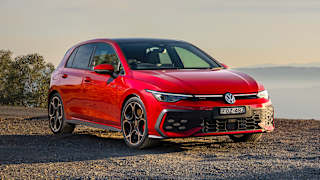At just over 4.4m long the XC40 fits the small SUV profile perfectly, and within that footprint a 2.7m wheelbase is the same as comparably sized mainstream models like the Toyota RAV4 and Mazda CX-5.
It’s also quite tall and there’s plenty of space for the driver and front passenger, with storage including a medium-size lidded box between the seats, a smaller flip-top compartment in front of it, as well as two cupholders (with another small lidded tray in front of them) and a wireless device charging pad in the centre console.
There are bottle holders in the sizeable front door pockets, a wide but slim glove box (cooled with bag hook), and an additional oddments box under the driver’s seat. Power and connectivity runs to a 12-volt socket and two USB ports (one for media, the other for charge only).
Move to the back and sitting behind the driver’s seat, set for my 183cm position, head and legroom is excellent, and the seat itself is nicely sculpted and comfortable.
There are modest pockets in the doors but unless the bottle you want to slip in there comes from the spirits section of a hotel mini-bar you’re out of luck on the liquid container front. Elastic nets on the front seatbacks are handy, as are coat and bag hooks in the roof.
A fold-down centre armrest contains two cupholders, and twin adjustable air vents in the rear of the front centre console will be welcomed by backseaters.
Then the boot offers up 460 litres of cargo space with the rear seats upright, which is more than enough to swallow our three-piece hard suitcase set (35, 68 and 105 litres), or the jumbo size CarsGuide pram.
Drop the 60/40 split-folding rear seats (they fold easily) and no less than 1336 litres of volume is at your disposal, and a through port in the centre of the back seat means you can stash long objects and still fit people in.
A deep storage well behind the driver’s side wheel tub boast a 12-volt socket and an elasticised strap to retain small bits and pieces, with a smaller sunken trench on the other side.
A grocery bag holder and foldable floor hatch increase flexibility, the latter able to sit up Toblerone-style to compartmentalise the cargo floor. Additional bag hooks and tie down anchors round out a useful, user-friendly interior package.
Towing capacity isn’t massive at 1800kg for a braked trailer (750kg unbraked), but it’s pretty handy for a car of this stature.











.png)
















































.png)
























 copy.png)
















